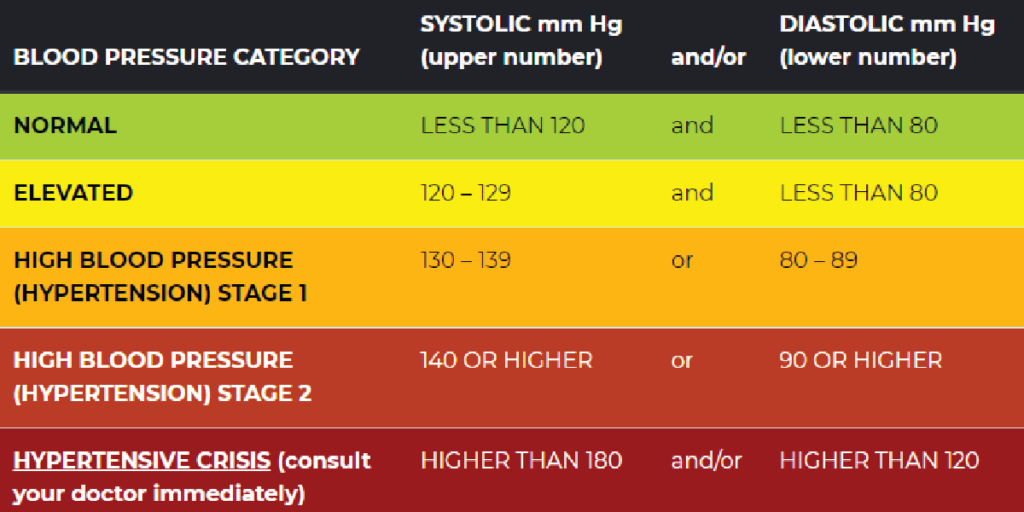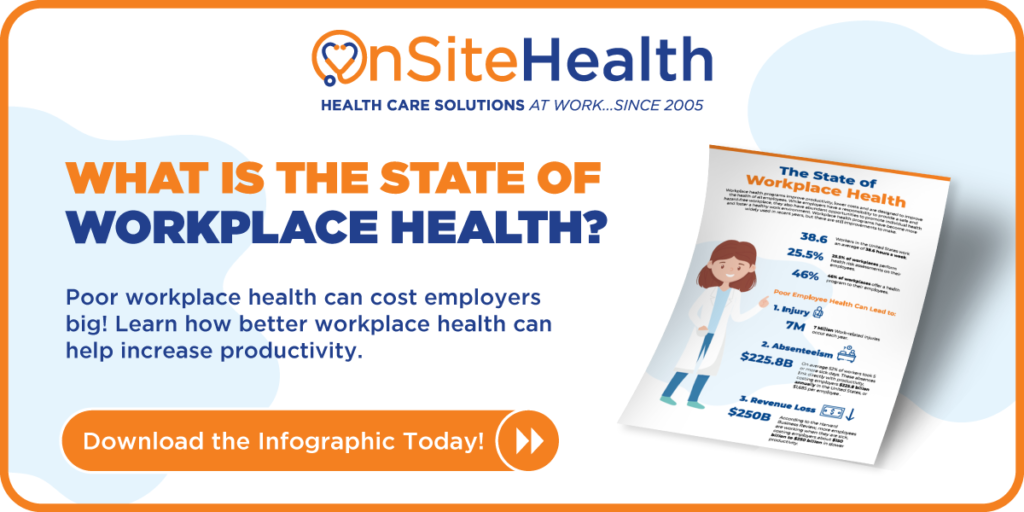When it comes to your health, blood pressure readings are vital and should be checked often. A blood pressure reading can vary depending on many factors including stress, anxiety, foods eaten, exercise, and more. But what is a good blood pressure reading? Let’s talk about it.
Want to know what OnSite Health can do for you?
>>Click Here for our ROI Fact Sheet<<
How is Blood Pressure Measured?
Blood pressure is the force that moves our blood throughout our circulatory system. Your total blood pressure is determined by measuring your systolic and diastolic blood pressures. Systolic blood pressure measures the force of your heart contracting and pushing out blood whereas diastolic blood pressure measures the pressure as your heart relaxes and fills with blood. Your blood pressure reading will be represented as systolic blood pressure over diastolic blood pressure, such as 127/76.

Blood Pressure Readings
Low
- Low blood pressure, also known as hypotension, is when your blood pressure reading is less than 90/60. With hypotension, you may feel lightheaded, weak, dizzy, or even faint. Low blood pressure is often associated with dehydration, blood loss, some medical conditions, or too much medication.
Normal
- For healthy blood pressure, your reading should show a systolic pressure between 90 and less than 120 and a diastolic pressure between 60 and less than 80. The American Heart Association considers blood pressure to be normal if both of the systolic and diastolic numbers are in these ranges.
Elevated
- If your blood pressure measures consistently from 120-129 systolic and less than 80 diastolic, you have elevated blood pressure. With elevated blood pressure, you should adopt a healthy lifestyle such as a more balanced diet and getting regular exercise so that the condition doesn’t worsen.
Hypertension
- Hypertension, or high blood pressure, is known as the silent killer because it often presents with no signs or symptoms until a reading is taken. Hypertension can be broken down into three stages depending on the severity of the situation. Stage 1 hypertension is when blood pressure reads between 130-139/80-89. Hypertension stage 2 is when blood pressure is consistently measuring at 140/90 or higher. In these stages, your doctor may prescribe blood pressure medication(s) as well as lifestyle changes.
- The final hypertension stage requires immediate medical attention and can lead to significant health issues. If your blood pressure measures 180/120 or higher, we recommend seeking medical attention as you could be experiencing a hypertensive crisis.
How to Improve Your Blood Pressure
Our blood pressure fluctuates depending on our age, lifestyle, foods we eat, and more. While older adults and family history can have an impact, the good news is that blood pressure can be controlled in most people. Here are some tips for improving your blood pressure:
Get up and Move!
- By exercising and keeping a healthy weight, you can lower your risk for high blood pressure. The American Heart Association recommends at least 150 minutes per week of moderate exercise for week for adults.
Reduce Your Sodium
- Sodium intake has a major impact on your blood pressure. Individuals should not consume more than 2,300 mg per day and for those with hypertension, sodium levels should be limited to about 1500 mg per day.
Eat Healthy
- A healthy diet should be rich in fruits, vegetables, whole grains, and dairy. Having good nutrition means that your body is getting all of the vitamins and minerals that it needs to work its best.
Manage Stress
- Feeling stress or anxious can have a direct impact on your blood pressure reading. If you’re feeling high levels of stress, try relaxing with mediation, exercise, or yoga.
OnSite Health Provides Blood Pressure and Health Screenings
At OnSite Health we specialize in on-site health screenings for all employees through staffing an onsite nurse. OnSite Health nurses provide health screenings for blood pressure, heart health, cholesterol, vision, and more. In addition, the cost for all à la carte services can be nullified or greatly minimized by staffing an OnSite Health nurse. Click here to see a real-world example.
Routine health screenings are a great step toward reducing healthcare costs, absenteeism and building a happier and healthier workforce. Interested in implementing an onsite nurse and health screenings at your organization? Contact us today.

